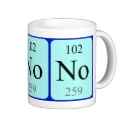|
|
Reference type: Journal
Authors: Oliveira HMV, Moreira FTC, Sales MG
Article Title: Ciprofloxacin-imprinted polymeric receptors as ionophores for potentiometric transduction.
Publication date: 2011
Journal: Electrochimica Acta
Volume: 56
Issue: (5)
Page numbers: 2017-2023.
DOI: 10.1016/j.electacta.2010.11.082
Alternative URL: http://www.sciencedirect.com/science/article/B6TG0-51K995N-F/2/88200905019958c88ad9e8111fa89e97
Abstract: A 3D-mirror synthetic receptor for ciprofloxacin host-guest interactions and potentiometric transduction is presented. The host cavity was shaped on a polymeric surface assembled with methacrylic acid or 2-vinyl pyridine monomers by radical polymerization. Molecularly imprinted particles were dispersed in 2-nitrophenyl octyl ether and entrapped in a poly(vinyl chloride) matrix. The sensors exhibited a near-Nernstian response in steady state evaluations. Slopes and detection limits ranged from 26.8 to 50.0 mV decade-1 and 1.0 x 10-5 to 2.7 x 10-5 mol L-1, respectively. Good selectivity was observed for trimethoprim, enrofloxacin, tetracycline, cysteine, galactose, hydroxylamine, creatinine, ammonium chloride, sucrose, glucose, sulphamerazine and sulfadiazine. The sensors were successfully applied to the determination of ciprofloxacin concentrations in fish and in pharmaceuticals. The method presented offered the advantages of simplicity, accuracy, applicability to colored and turbid samples and automation feasibility, as well as confirming the use of molecularly imprinted polymers as ionophores for organic ion recognition in potentiometric transduction
Template and target information: ciprofloxacin
Author keywords: Ciprofloxacin, Molecularly imprinted sensors, Potentiometry, Aquaculture
|


 Element 13 card - Aluminium
Element 13 card - Aluminium














 Element 102 mug - Nobelium
Element 102 mug - Nobelium






